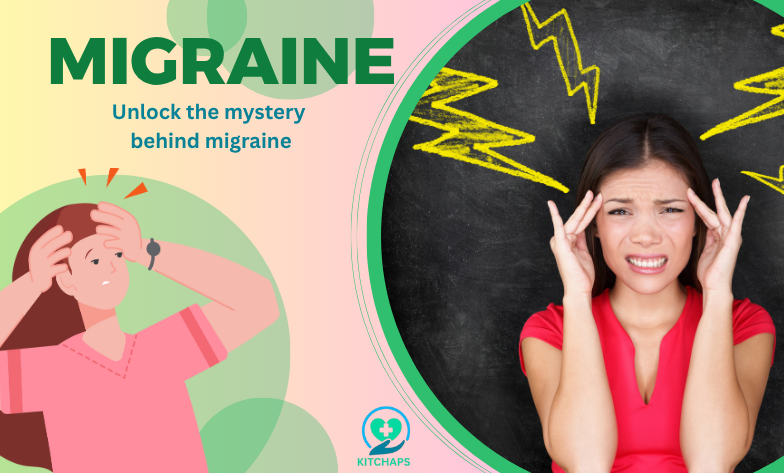Have you ever ignored the pain in your head? You would have thought about this as a headache or something else. In the world, migraine is a neurological disorder, and it is not just a simple headache. Still, some myths keep going, which are leading to the wrong diagnosis and wrong treatment, too.
In this blog, we will highlight migraine, symptoms, causes, diagnosis, prevention, and many more. Also, discovered the difference between a headache and Migraine.
About Migraine: A Neurological Disorder
Migraines are a long-term neurological disorder and a complicated condition. It affects 12% population of the world, targeting both men and women. Migraines have signs that affect your whole body and not just the head. These attacks last for various hours to days, and sometimes they disturb your daily life too.
It is the second cause of disability in the world among those aged between 15 to 49. It is not a bad headache but a neurological condition that changes brain activity, cells, and chemicals.
Types of Migraine: Beyond the Basics
Migraine have many forms and all have unique features. Understanding the kinds is important for precise diagnosis and proper treatment. The table is given below:
| Types | Features |
| Common Migraine | The most common type. Moderate to Severe pain. Occurs on one side of the head. Nausea, Vomiting, and sensitivity to light and sound. |
| Classic Migraine | 25% of people experience classic migraine. Visual disturbances. Sensory changes or speech difficulty. Preceding the headache phase. |
| Ocular Migraine (Retinal) | Visual disturbances (or temporary blindness). Symptoms are reversible. |
| Vestibular Migraine | Dizziness, vertigo, and steady disturbances. Often with pain or no headache. Sometimes misdiagnosed as an ear problem. |
| Chronic Migraine | Recognized when headaches occur more than 15 days per month. 8 days featuring migraine signs for 3 months. |
| Acephalgic (Silent) Migraine | Occur without typical headaches. |
Causes: What Triggers a Migraine?
The exact cause is unclear, but it is now considered a neurological disorder. It involves a difficult interchange between brain networks, neurotransmitters, and blood vessels. Heredity plays an important role because family history increases the risks.
Some of the common causes include:
- Changes in hormones
- Anxiety and Stress
- Disturbance in sleeping
- Various food and beverages
- Changes in Weather
- Sensory Stimuli
Symptoms: More Than Just Pain
Migraine symptoms can range broadly, but the progression through the four phases is:
Prodrome
It is some hours or days before a headache; these symptoms occur in people who have migraine, including:
- Symptoms like fatigue, tiredness, changes in mood, cravings for food, neck stiffness, and increased urination.
- You will feel sensitive to light and sound. Sometimes, it makes you feel uncomfortable and painful.
- You will also feel some signs of the digestive system, like bloating, constipation, and diarrhea.
Aura (In some cases)
People who have auras in a short time before a headache. These signs affect your nervous system and sometimes your vision. Mostly they start at 5-20 minutes and last for one hour. These symptoms include:
- Disturbances in vision, like flash lighting and blind spots.
- Some sensory changes, such as tingling and numbness.
- Speech problems, as well as you may not speak words properly.
- Sound of a ring in your ears.
- You feel some weakness in your body.
Headache
During a headache, you may feel:
- From moderate to severe pain, sometimes one-sided.
- A feeling of vomiting.
- Uncomfortable with light, sound, and smell.
- Worse during physical activity.
- Feel dizzy, runny nose and sleep disturbances occur.
Postdrome
You may feel confused and void for a day. Some people may feel eloped, and some frequent movements of pain occur briefly.
Diagnosis: Getting it right
Migraine is identified clinically based on signs and its history. There is no particular and fixed test. A detailed consideration helps in finding the causes of a headache. Imaging and EEG, such as MRI and CT Scans, are not commonly used for diagnosis if some other neurological conditions are examined. Also, keep a headache diary for tracking headache patterns and causes.
Migraine vs Headache: Spot the difference
| Feature | Migraine | Headache |
| Location | On one side | On both sides |
| Pain Quality | Beating and pounding | Dull and sharp |
| Duration | 4-72 hours | 5 min- 4 hours |
| Symptoms | Nausea, light, and sound sensitivity | Rare |
| Aura | Common | Rare |
| Causes | Hormones, Sleep, weather, food, and stress | Posture, alcohol, stress, and smells |
Prevention and Treatment: What works?
- Do some lifestyle changes like maintaining regular sleep and meal schedules, managing stress with some relieving methods, also determining and ignoring personal causes.
- Take some medicines like Naxdom 500 and Excedrin Migraine. It is beneficial for many, but its overconsumption leads to repeated headaches.
- There are some treatments such as beta-blockers, anti-seizure medicines, CGRP, and some lifestyle changes.
- Gepants and Ditans are the newest options for those who cannot endure triptans.
Conclusion
It is the most misunderstood condition. Knowing its symptoms, causes, prevention, and taking care can change your life. If you think you have migraine, always take advice from your doctor for the full treatment plan.
Disclaimer: The information provided is only for knowledge. It is not medical advice; always consult your doctor before taking medicine. Do not overlook the doctor’s medical advice because you have read it here.
Frequently Asked Questions (FAQs):
A. Yes, because genes play an important role, and they increase your risk.
A. Some of the report says that food causes migraines, but there is no strong proof.
A. Migraines are more severe and one-sided, and regular headaches are mild and generalized.
A. It is the combination of acetaminophen, aspirin, and caffeine to relieve migraine.
Also read about:

